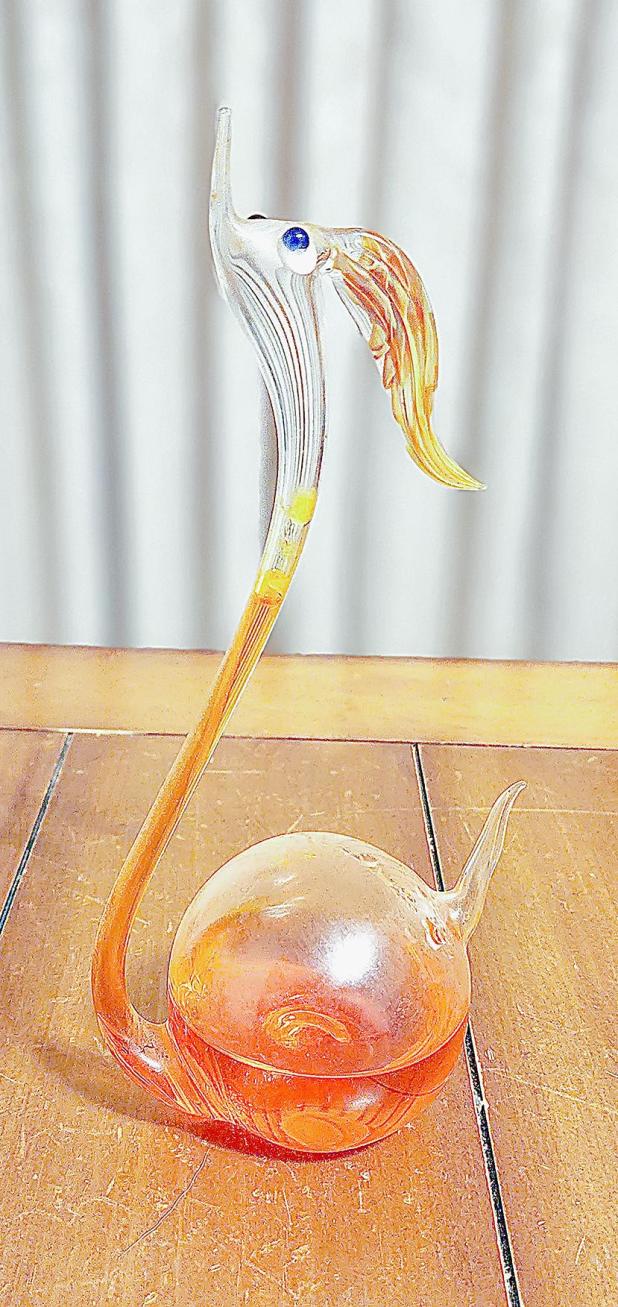
Courtesy Photo
Tandy Overstreet’s glass weather swan has become a social media sensation.
Glass weather swan a social media sensation
Perkins County resident Tandy Overstreet never imagined that one of her family’s heirlooms would become a social media sensation.
However, that is exactly what has happened to Overstreet’s nearly half-century old glass weather swan.
The swan is a weather glass, or a small, open barometer filled with water and food coloring. It is a simple instrument designed to indicate when atmospheric pressure rises and falls, which causes the water in the spout to fall or rise, according to the Regional and Mesoscale Meteorology Branch of the Cooperative Institute for Research in the Atmosphere out of Fort Collins, Colorado.
From what Overstreet knows of her swan, it is more than 50 years old, and one of four her parents had made by a glassblower in Colorado, possibly the Estes Park area, she said. The swans were given to family members as gifts.
“Both sets of my grandparents got one, my aunt and uncle got one and my parents kept one,” she said. “Unfortunately, there are only two left. My brother now has my aunt and uncle’s and I have what was originally my grandparents’,” she said.
Many of Overstreet’s family members have passed away now, so detailed information on the swan is limited, she said.
Overstreet said the swans are extremely fragile, but hers survived all these years through several moves.
Overstreet and her family have depended on the swan for years to predict the weather.
“They are exceptionally accurate on the weather changes,” she said.
So, before and during the mid-December 2022 blizzard, Overstreet posted a photo of the swan to her social media page just for fun. She did not know, however, it would cause such a stir.
“I definitely didn’t expect a picture of it I posted on Facebook to make it so famous,” she said. “I’ve had people message me to find out what the swan is showing when we know some weather is headed this way. It’s become Perkins County’s weather man,” she said.
How does it work?
According to the RMMB website, the weather glass typically consists of a glass bottle with an open spout. The bottle may be pear-shaped and is often flattened on one side so it can be hung on a wall.
The bottle is partially filled with water that has a dye in it to make it easily visible. The surface of the water in the bottle lies at a level above the opening of the spout into the bottle.
The principle is that the air left in the bottle above the water exerts the pressure of the air at the time the bottle was filled, while the liquid in the spout is exposed to the changing atmospheric pressure.
As the atmospheric pressure falls, the water in the spout rises, and vice versa. Because the spout is much narrower than the bottle, changes in water level in the bottle are amplified in the spout and so are easily visible.
The weather glass does not measure the actual air pressure, but gives only a qualitative indication of the changes in the air pressure.
It can be used as a forecast tool: rising water in the spout indicates decreasing atmospheric pressure and perhaps clouds or precipitation, while falling water in the spout indicates increasing pressure and possible improving weather
History
The weather glass or a water barometer, was invented in the 16th or 17th century. The website britannica.com says that the Italian physicist and mathematician Evangelista Torricelli invented it. Torricelli served as an assistant to Galileo, astronomer, physicist and engineer.
However, the RMMB website credits the Dutch nobleman Gheijsbrecht de Donckere as the inventor. In either case, it is agreed that the German poet and writer Johan Wolfgang von Goethe, who had a great interest in the weather, became one of the most famous users of the weather glass in Europe.
According to the RMMB website, during his travels, Goethe discovered the glass and introduced it to German-speaking countries. His promotion of the instrument linked it to him to the point where it became known as the Goethe barometer. The device has also been called a storm glass or a water barometer.
According to RMMB, the pilgrims probably brought the weather glass to America in the 1620s, where it became known as a Cape Cod weather glass, a thunder glass or a thunder bottle. It was a popular tool with fishermen and farmers in the 17th to 19th centuries because it was simple, inexpensive and could give a hint of coming weather through its indication of pressure changes.
The weather glass should be mounted out of the sun in a spot where the temperature does not change much, since the liquid within the bottle will expand and contract with increasing or decreasing temperatures, which will in turn cause false readings of pressure change.
County ‘weatherman’
Overstreet said she will continue to give her social media friends updates on the swan, and that it has been pretty fun to share a part of her family’s history with others, and to also help people to be able to predict incoming weather.
“I’m blown away by the response to this silly swan,” she said.
“I’ve had a couple comments on my facebook posts that some people don’t listen to the weather channel anymore, but wait for an update on what the swan is showing. The comments on my posts are fun to read,” she said.
